2004 FORD F SERIES MOTORHOME AND COMMERCIAL CHASSIS check engine light
[x] Cancel search: check engine lightPage 67 of 120
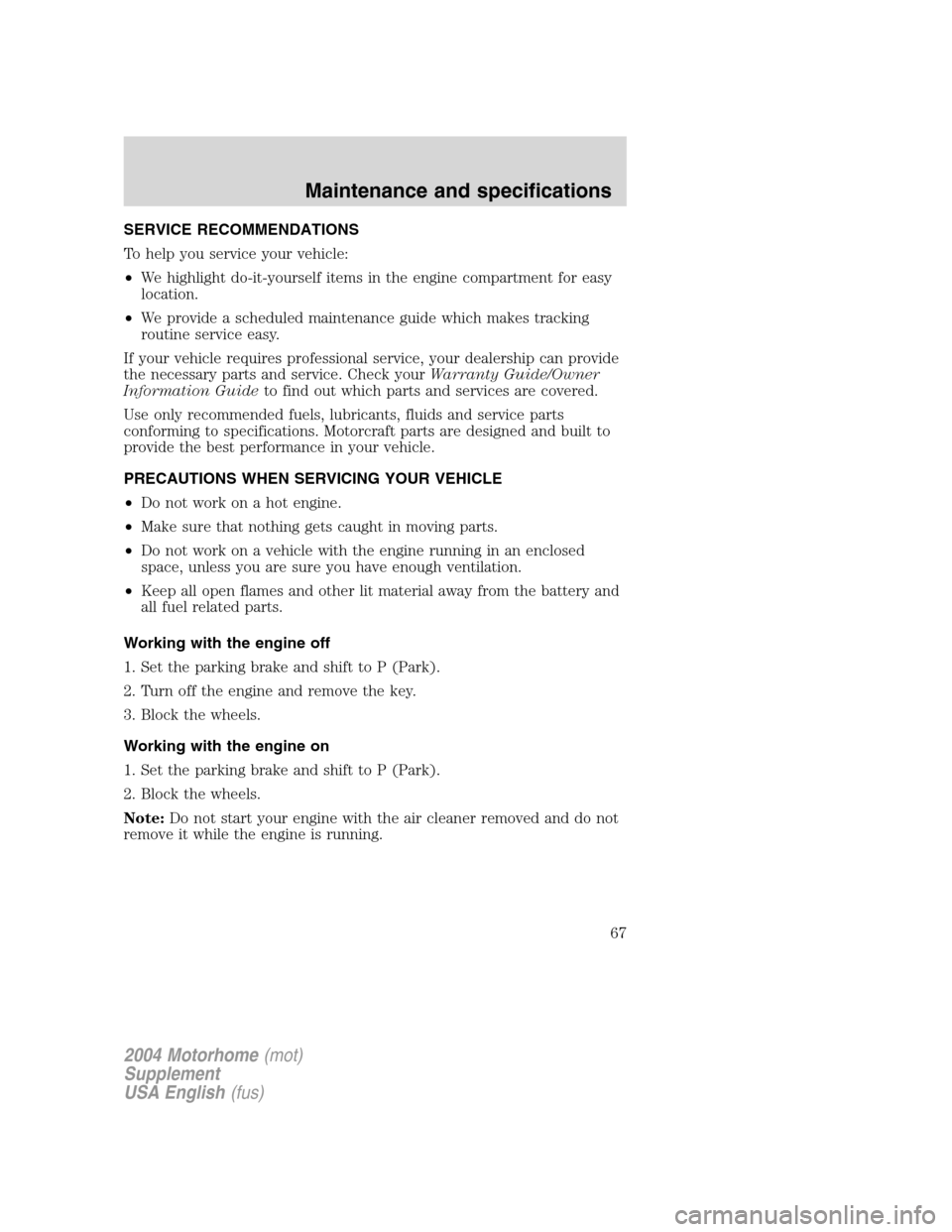
SERVICE RECOMMENDATIONS
To help you service your vehicle:
•We highlight do-it-yourself items in the engine compartment for easy
location.
•We provide a scheduled maintenance guide which makes tracking
routine service easy.
If your vehicle requires professional service, your dealership can provide
the necessary parts and service. Check yourWarranty Guide/Owner
Information Guideto find out which parts and services are covered.
Use only recommended fuels, lubricants, fluids and service parts
conforming to specifications. Motorcraft parts are designed and built to
provide the best performance in your vehicle.
PRECAUTIONS WHEN SERVICING YOUR VEHICLE
•Do not work on a hot engine.
•Make sure that nothing gets caught in moving parts.
•Do not work on a vehicle with the engine running in an enclosed
space, unless you are sure you have enough ventilation.
•Keep all open flames and other lit material away from the battery and
all fuel related parts.
Working with the engine off
1. Set the parking brake and shift to P (Park).
2. Turn off the engine and remove the key.
3. Block the wheels.
Working with the engine on
1. Set the parking brake and shift to P (Park).
2. Block the wheels.
Note:Do not start your engine with the air cleaner removed and do not
remove it while the engine is running.
2004 Motorhome(mot)
Supplement
USA English(fus)
Maintenance and specifications
Maintenance and specifications
67
Page 71 of 120
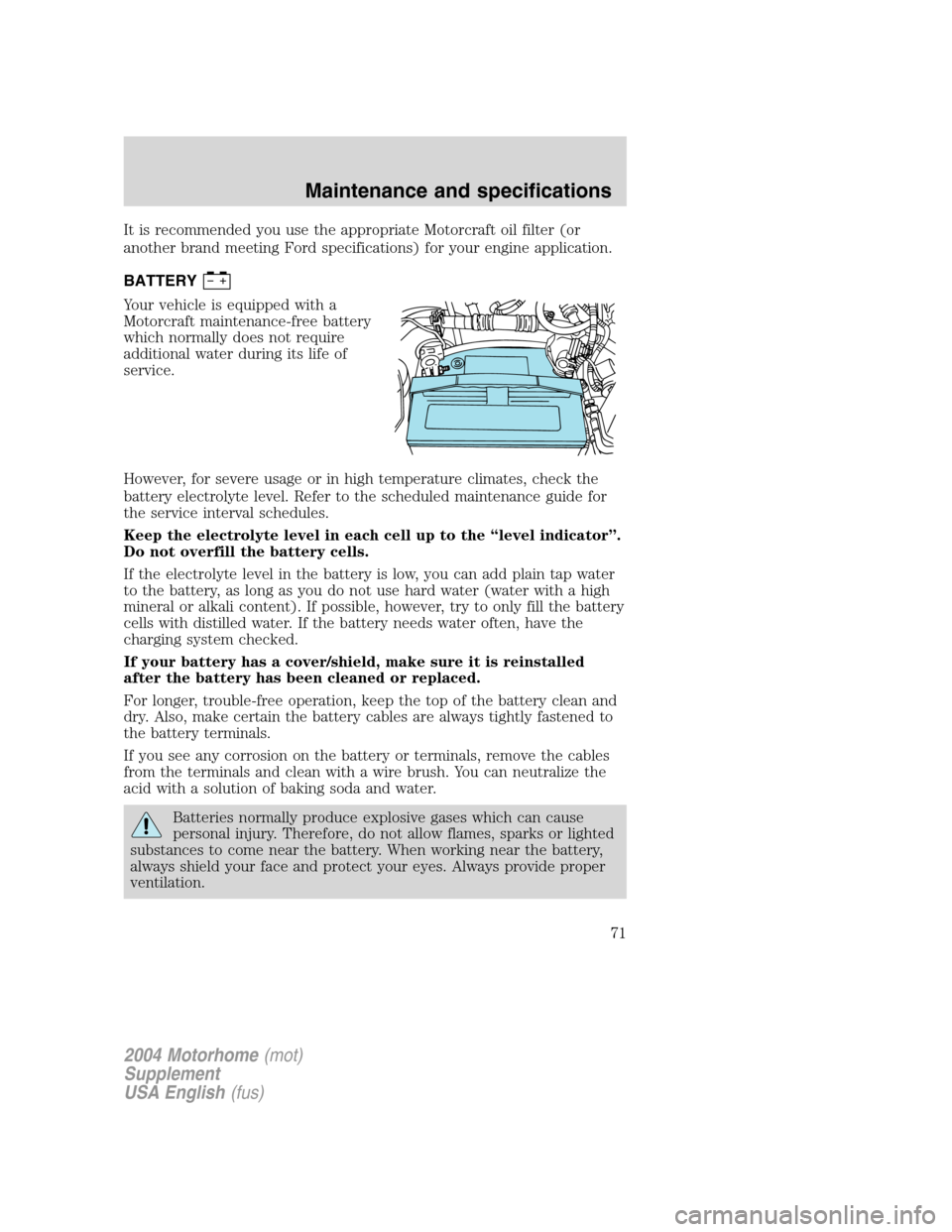
It is recommended you use the appropriate Motorcraft oil filter (or
another brand meeting Ford specifications) for your engine application.
BATTERY
Your vehicle is equipped with a
Motorcraft maintenance-free battery
which normally does not require
additional water during its life of
service.
However, for severe usage or in high temperature climates, check the
battery electrolyte level. Refer to the scheduled maintenance guide for
the service interval schedules.
Keep the electrolyte level in each cell up to the“level indicator”.
Do not overfill the battery cells.
If the electrolyte level in the battery is low, you can add plain tap water
to the battery, as long as you do not use hard water (water with a high
mineral or alkali content). If possible, however, try to only fill the battery
cells with distilled water. If the battery needs water often, have the
charging system checked.
If your battery has a cover/shield, make sure it is reinstalled
after the battery has been cleaned or replaced.
For longer, trouble-free operation, keep the top of the battery clean and
dry. Also, make certain the battery cables are always tightly fastened to
the battery terminals.
If you see any corrosion on the battery or terminals, remove the cables
from the terminals and clean with a wire brush. You can neutralize the
acid with a solution of baking soda and water.
Batteries normally produce explosive gases which can cause
personal injury. Therefore, do not allow flames, sparks or lighted
substances to come near the battery. When working near the battery,
always shield your face and protect your eyes. Always provide proper
ventilation.
2004 Motorhome(mot)
Supplement
USA English(fus)
Maintenance and specifications
71
Page 76 of 120
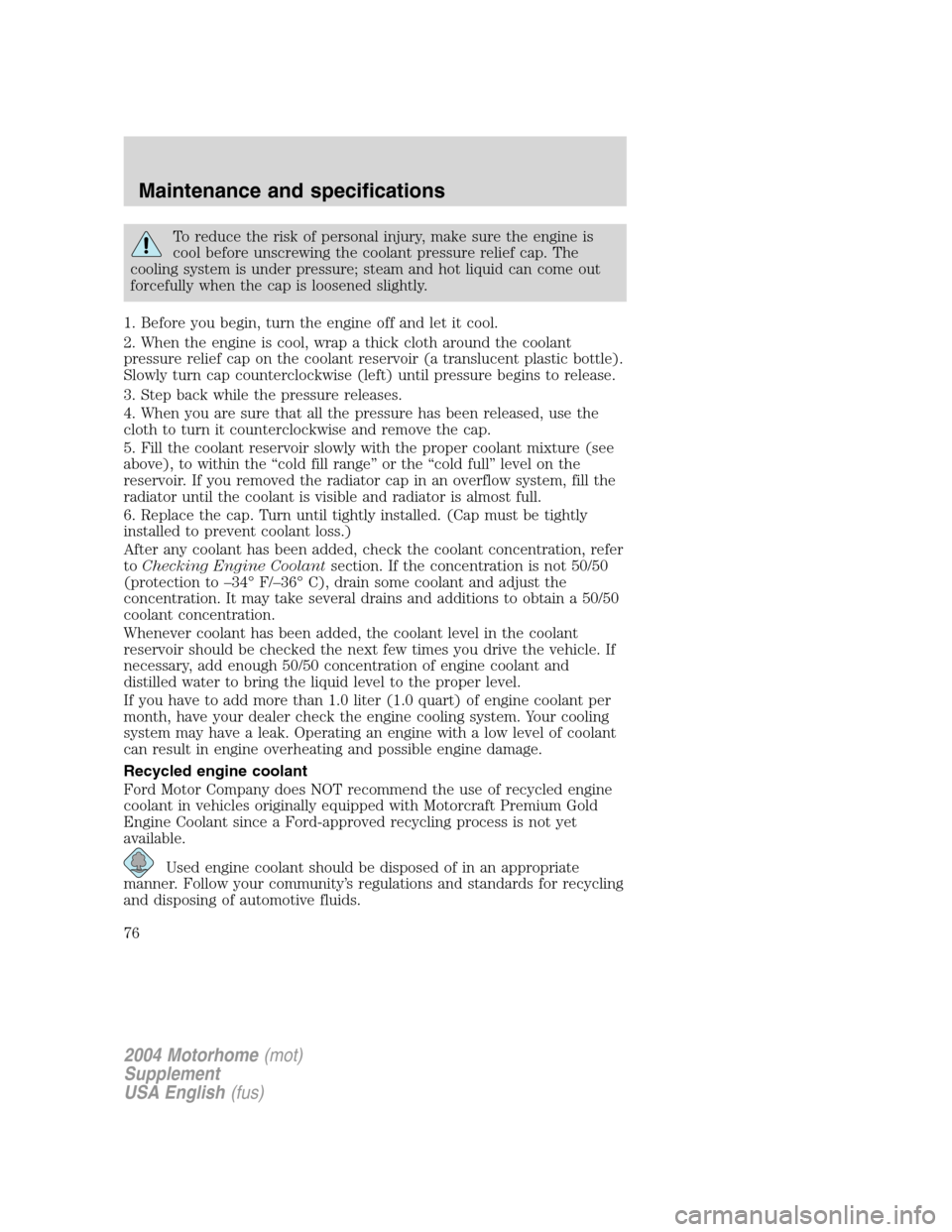
To reduce the risk of personal injury, make sure the engine is
cool before unscrewing the coolant pressure relief cap. The
cooling system is under pressure; steam and hot liquid can come out
forcefully when the cap is loosened slightly.
1. Before you begin, turn the engine off and let it cool.
2. When the engine is cool, wrap a thick cloth around the coolant
pressure relief cap on the coolant reservoir (a translucent plastic bottle).
Slowly turn cap counterclockwise (left) until pressure begins to release.
3. Step back while the pressure releases.
4. When you are sure that all the pressure has been released, use the
cloth to turn it counterclockwise and remove the cap.
5. Fill the coolant reservoir slowly with the proper coolant mixture (see
above), to within the“cold fill range”or the“cold full”level on the
reservoir. If you removed the radiator cap in an overflow system, fill the
radiator until the coolant is visible and radiator is almost full.
6. Replace the cap. Turn until tightly installed. (Cap must be tightly
installed to prevent coolant loss.)
After any coolant has been added, check the coolant concentration, refer
toChecking Engine Coolantsection. If the concentration is not 50/50
(protection to–34°F/–36°C), drain some coolant and adjust the
concentration. It may take several drains and additions to obtain a 50/50
coolant concentration.
Whenever coolant has been added, the coolant level in the coolant
reservoir should be checked the next few times you drive the vehicle. If
necessary, add enough 50/50 concentration of engine coolant and
distilled water to bring the liquid level to the proper level.
If you have to add more than 1.0 liter (1.0 quart) of engine coolant per
month, have your dealer check the engine cooling system. Your cooling
system may have a leak. Operating an engine with a low level of coolant
can result in engine overheating and possible engine damage.
Recycled engine coolant
Ford Motor Company does NOT recommend the use of recycled engine
coolant in vehicles originally equipped with Motorcraft Premium Gold
Engine Coolant since a Ford-approved recycling process is not yet
available.
Used engine coolant should be disposed of in an appropriate
manner. Follow your community’s regulations and standards for recycling
and disposing of automotive fluids.
2004 Motorhome(mot)
Supplement
USA English(fus)
Maintenance and specifications
76
Page 78 of 120
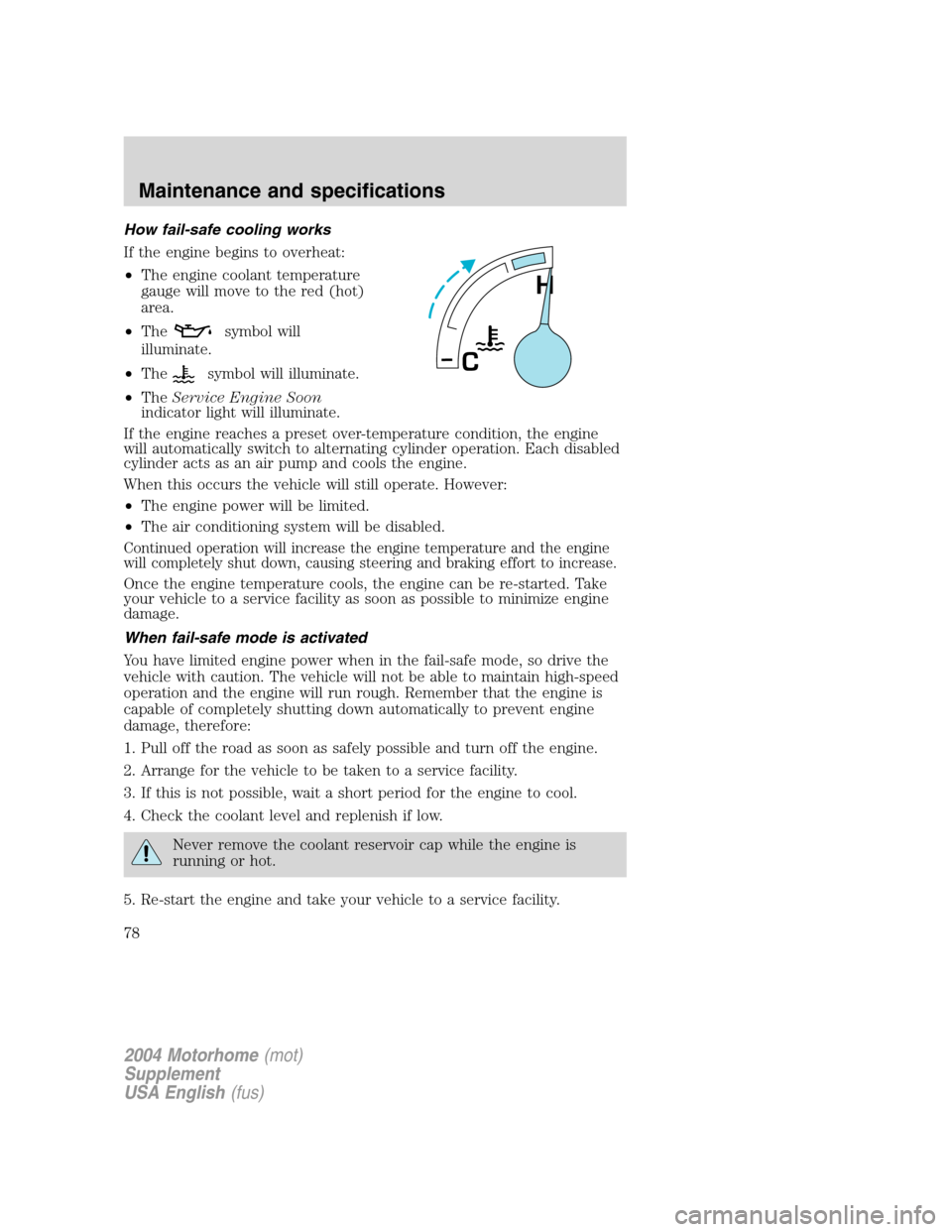
How fail-safe cooling works
If the engine begins to overheat:
•The engine coolant temperature
gauge will move to the red (hot)
area.
•The
symbol will
illuminate.
•The
symbol will illuminate.
•TheService Engine Soon
indicator light will illuminate.
If the engine reaches a preset over-temperature condition, the engine
will automatically switch to alternating cylinder operation. Each disabled
cylinder acts as an air pump and cools the engine.
When this occurs the vehicle will still operate. However:
•The engine power will be limited.
•The air conditioning system will be disabled.
Continued operation will increase the engine temperature and the engine
will completely shut down, causing steering and braking effort to increase.
Once the engine temperature cools, the engine can be re-started. Take
your vehicle to a service facility as soon as possible to minimize engine
damage.
When fail-safe mode is activated
You have limited engine power when in the fail-safe mode, so drive the
vehicle with caution. The vehicle will not be able to maintain high-speed
operation and the engine will run rough. Remember that the engine is
capable of completely shutting down automatically to prevent engine
damage, therefore:
1. Pull off the road as soon as safely possible and turn off the engine.
2. Arrange for the vehicle to be taken to a service facility.
3. If this is not possible, wait a short period for the engine to cool.
4. Check the coolant level and replenish if low.
Never remove the coolant reservoir cap while the engine is
running or hot.
5. Re-start the engine and take your vehicle to a service facility.
H
C
2004 Motorhome(mot)
Supplement
USA English(fus)
Maintenance and specifications
78
Page 87 of 120
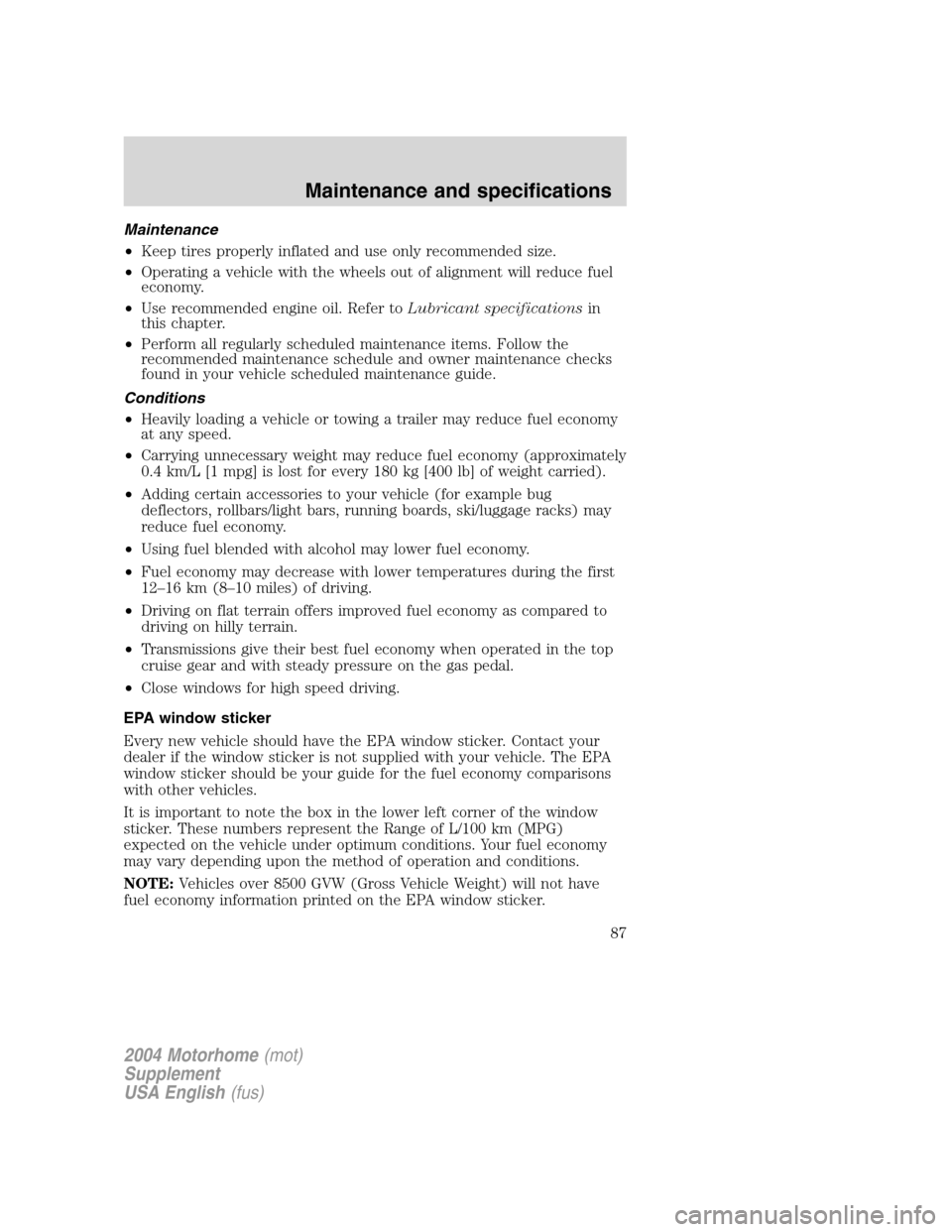
Maintenance
•Keep tires properly inflated and use only recommended size.
•Operating a vehicle with the wheels out of alignment will reduce fuel
economy.
•Use recommended engine oil. Refer toLubricant specificationsin
this chapter.
•Perform all regularly scheduled maintenance items. Follow the
recommended maintenance schedule and owner maintenance checks
found in your vehicle scheduled maintenance guide.
Conditions
•Heavily loading a vehicle or towing a trailer may reduce fuel economy
at any speed.
•Carrying unnecessary weight may reduce fuel economy (approximately
0.4 km/L [1 mpg] is lost for every 180 kg [400 lb] of weight carried).
•Adding certain accessories to your vehicle (for example bug
deflectors, rollbars/light bars, running boards, ski/luggage racks) may
reduce fuel economy.
•Using fuel blended with alcohol may lower fuel economy.
•Fuel economy may decrease with lower temperatures during the first
12–16 km (8–10 miles) of driving.
•Driving on flat terrain offers improved fuel economy as compared to
driving on hilly terrain.
•Transmissions give their best fuel economy when operated in the top
cruise gear and with steady pressure on the gas pedal.
•Close windows for high speed driving.
EPA window sticker
Every new vehicle should have the EPA window sticker. Contact your
dealer if the window sticker is not supplied with your vehicle. The EPA
window sticker should be your guide for the fuel economy comparisons
with other vehicles.
It is important to note the box in the lower left corner of the window
sticker. These numbers represent the Range of L/100 km (MPG)
expected on the vehicle under optimum conditions. Your fuel economy
may vary depending upon the method of operation and conditions.
NOTE:Vehicles over 8500 GVW (Gross Vehicle Weight) will not have
fuel economy information printed on the EPA window sticker.
2004 Motorhome(mot)
Supplement
USA English(fus)
Maintenance and specifications
87
Page 89 of 120
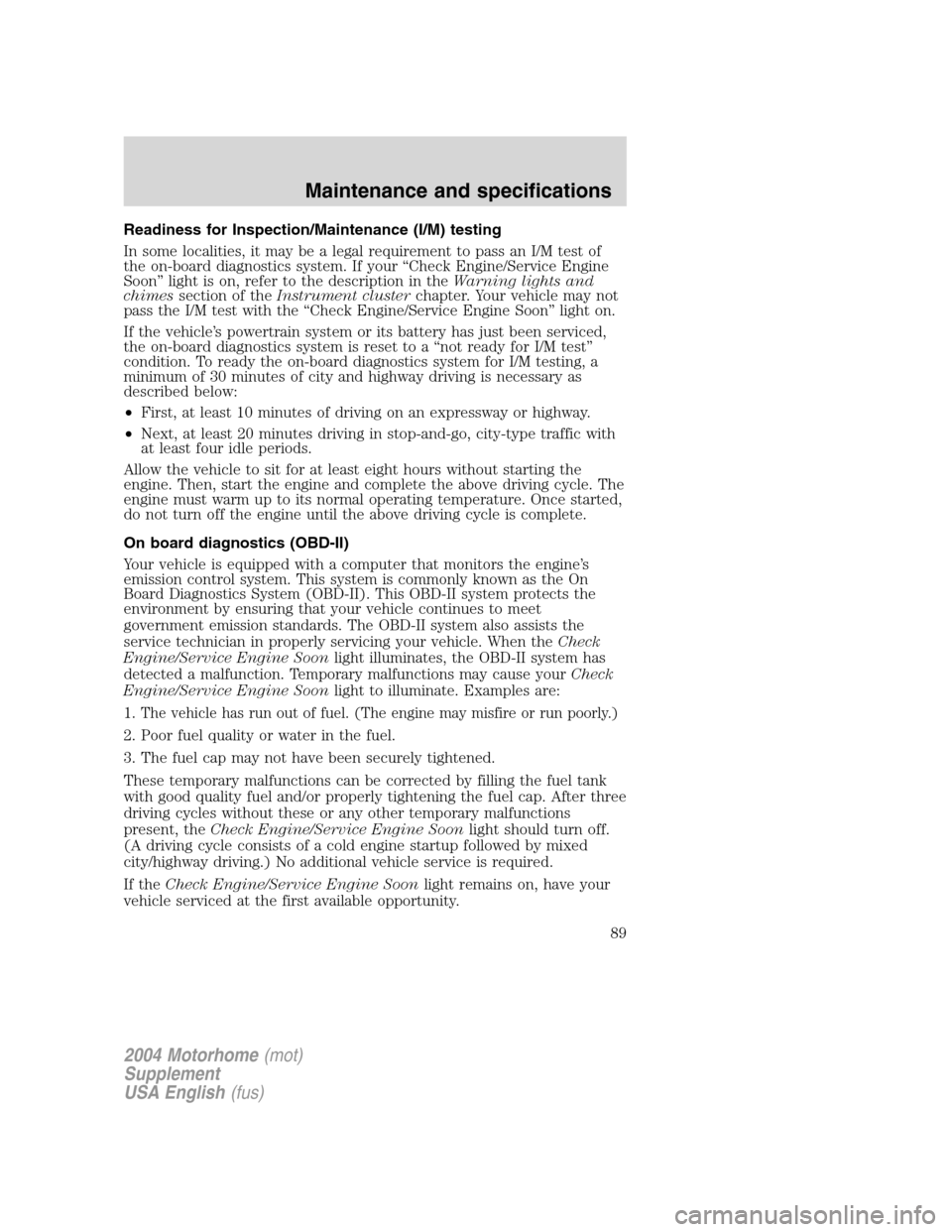
Readiness for Inspection/Maintenance (I/M) testing
In some localities, it may be a legal requirement to pass an I/M test of
the on-board diagnostics system. If your“Check Engine/Service Engine
Soon”light is on, refer to the description in theWarning lights and
chimessection of theInstrument clusterchapter. Your vehicle may not
pass the I/M test with the“Check Engine/Service Engine Soon”light on.
If the vehicle’s powertrain system or its battery has just been serviced,
the on-board diagnostics system is reset to a“not ready for I/M test”
condition. To ready the on-board diagnostics system for I/M testing, a
minimum of 30 minutes of city and highway driving is necessary as
described below:
•First, at least 10 minutes of driving on an expressway or highway.
•Next, at least 20 minutes driving in stop-and-go, city-type traffic with
at least four idle periods.
Allow the vehicle to sit for at least eight hours without starting the
engine. Then, start the engine and complete the above driving cycle. The
engine must warm up to its normal operating temperature. Once started,
do not turn off the engine until the above driving cycle is complete.
On board diagnostics (OBD-II)
Your vehicle is equipped with a computer that monitors the engine’s
emission control system. This system is commonly known as the On
Board Diagnostics System (OBD-II). This OBD-II system protects the
environment by ensuring that your vehicle continues to meet
government emission standards. The OBD-II system also assists the
service technician in properly servicing your vehicle. When theCheck
Engine/Service Engine Soonlight illuminates, the OBD-II system has
detected a malfunction. Temporary malfunctions may cause yourCheck
Engine/Service Engine Soonlight to illuminate. Examples are:
1.
The vehicle has run out of fuel. (The engine may misfire or run poorly.)
2. Poor fuel quality or water in the fuel.
3. The fuel cap may not have been securely tightened.
These temporary malfunctions can be corrected by filling the fuel tank
with good quality fuel and/or properly tightening the fuel cap. After three
driving cycles without these or any other temporary malfunctions
present, theCheck Engine/Service Engine Soonlight should turn off.
(A driving cycle consists of a cold engine startup followed by mixed
city/highway driving.) No additional vehicle service is required.
If theCheck Engine/Service Engine Soonlight remains on, have your
vehicle serviced at the first available opportunity.
2004 Motorhome(mot)
Supplement
USA English(fus)
Maintenance and specifications
89
Page 116 of 120
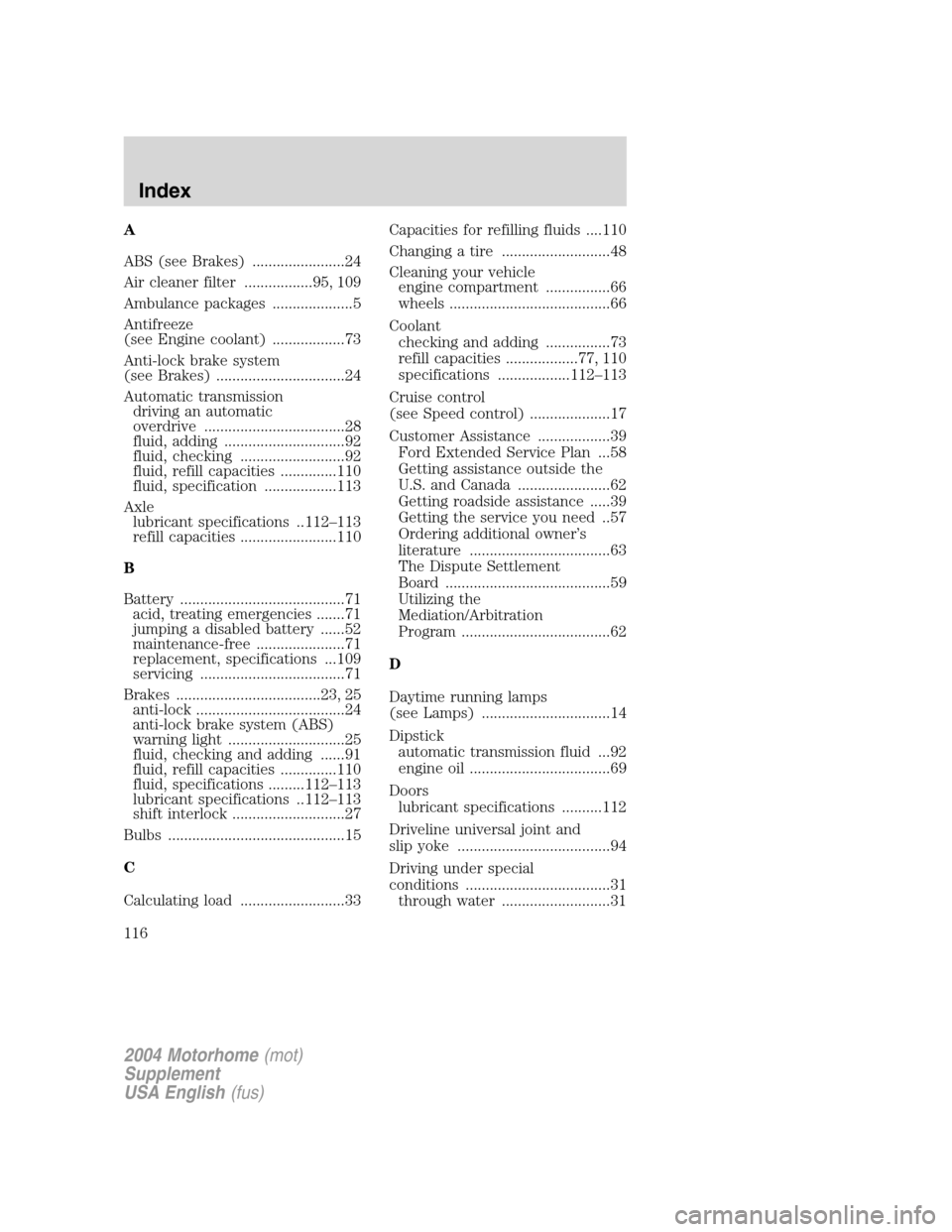
A
ABS (see Brakes) .......................24
Air cleaner filter .................95, 109
Ambulance packages ....................5
Antifreeze
(see Engine coolant) ..................73
Anti-lock brake system
(see Brakes) ................................24
Automatic transmission
driving an automatic
overdrive ...................................28
fluid, adding ..............................92
fluid, checking ..........................92
fluid, refill capacities ..............110
fluid, specification ..................113
Axle
lubricant specifications ..112–113
refill capacities ........................110
B
Battery .........................................71
acid, treating emergencies .......71
jumping a disabled battery ......52
maintenance-free ......................71
replacement, specifications ...109
servicing ....................................71
Brakes ....................................23, 25
anti-lock .....................................24
anti-lock brake system (ABS)
warning light .............................25
fluid, checking and adding ......91
fluid, refill capacities ..............110
fluid, specifications .........112–113
lubricant specifications ..112–113
shift interlock ............................27
Bulbs ............................................15
C
Calculating load ..........................33Capacities for refilling fluids ....110
Changing a tire ...........................48
Cleaning your vehicle
engine compartment ................66
wheels ........................................66
Coolant
checking and adding ................73
refill capacities ..................77, 110
specifications ..................112–113
Cruise control
(see Speed control) ....................17
Customer Assistance ..................39
Ford Extended Service Plan ...58
Getting assistance outside the
U.S. and Canada .......................62
Getting roadside assistance .....39
Getting the service you need ..57
Ordering additional owner’s
literature ...................................63
The Dispute Settlement
Board .........................................59
Utilizing the
Mediation/Arbitration
Program .....................................62
D
Daytime running lamps
(see Lamps) ................................14
Dipstick
automatic transmission fluid ...92
engine oil ...................................69
Doors
lubricant specifications ..........112
Driveline universal joint and
slip yoke ......................................94
Driving under special
conditions ....................................31
through water ...........................31
2004 Motorhome(mot)
Supplement
USA English(fus)
Index
116
Page 117 of 120
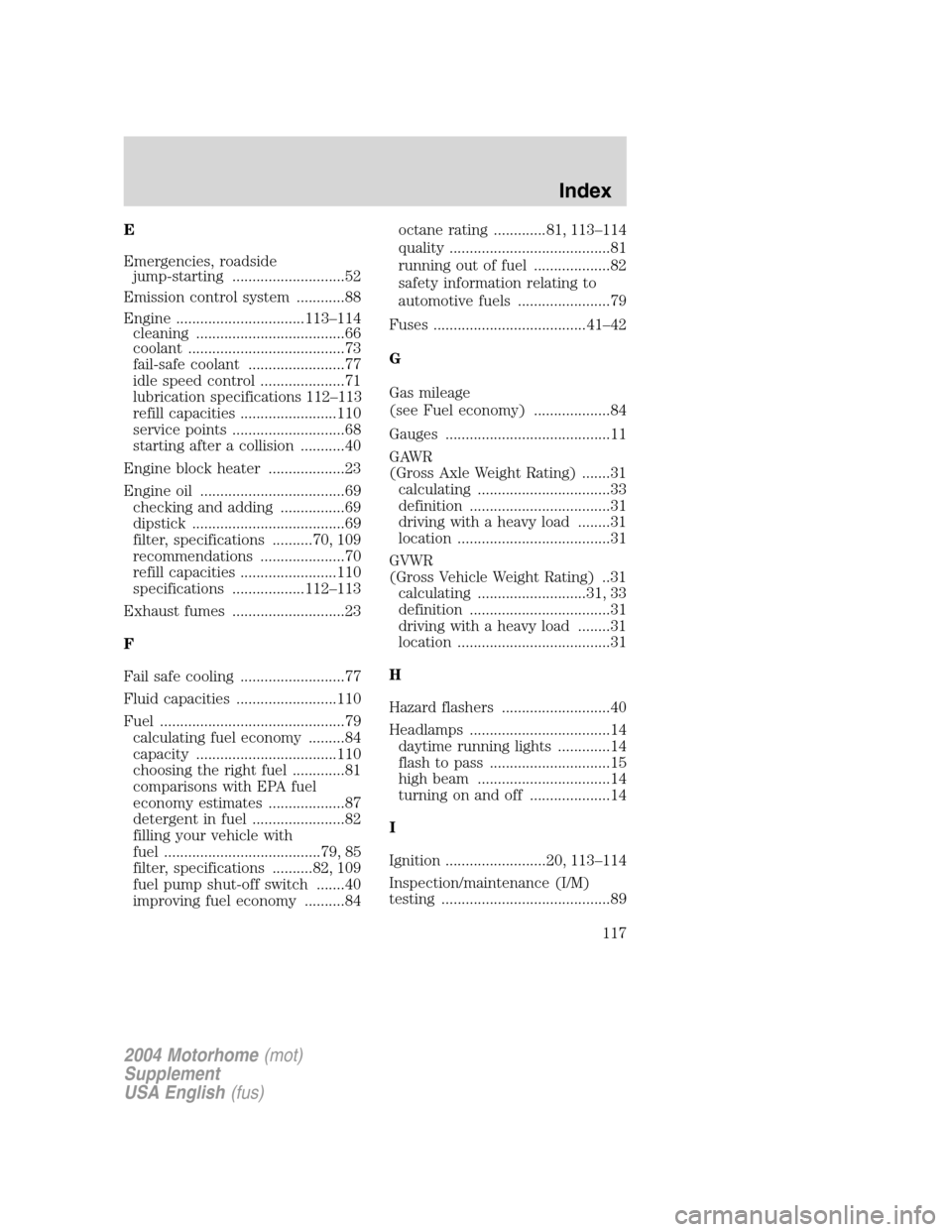
E
Emergencies, roadside
jump-starting ............................52
Emission control system ............88
Engine ................................113–114
cleaning .....................................66
coolant .......................................73
fail-safe coolant ........................77
idle speed control .....................71
lubrication specifications 112–113
refill capacities ........................110
service points ............................68
starting after a collision ...........40
Engine block heater ...................23
Engine oil ....................................69
checking and adding ................69
dipstick ......................................69
filter, specifications ..........70, 109
recommendations .....................70
refill capacities ........................110
specifications ..................112–113
Exhaust fumes ............................23
F
Fail safe cooling ..........................77
Fluid capacities .........................110
Fuel ..............................................79
calculating fuel economy .........84
capacity ...................................110
choosing the right fuel .............81
comparisons with EPA fuel
economy estimates ...................87
detergent in fuel .......................82
filling your vehicle with
fuel .......................................79, 85
filter, specifications ..........82, 109
fuel pump shut-off switch .......40
improving fuel economy ..........84octane rating .............81, 113–114
quality ........................................81
running out of fuel ...................82
safety information relating to
automotive fuels .......................79
Fuses ......................................41–42
G
Gas mileage
(see Fuel economy) ...................84
Gauges .........................................11
GAWR
(Gross Axle Weight Rating) .......31
calculating .................................33
definition ...................................31
driving with a heavy load ........31
location ......................................31
GVWR
(Gross Vehicle Weight Rating) ..31
calculating ...........................31, 33
definition ...................................31
driving with a heavy load ........31
location ......................................31
H
Hazard flashers ...........................40
Headlamps ...................................14
daytime running lights .............14
flash to pass ..............................15
high beam .................................14
turning on and off ....................14
I
Ignition .........................20, 113–114
Inspection/maintenance (I/M)
testing ..........................................89
2004 Motorhome(mot)
Supplement
USA English(fus)
Index
117